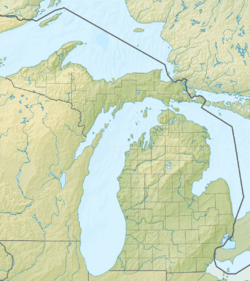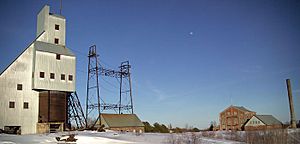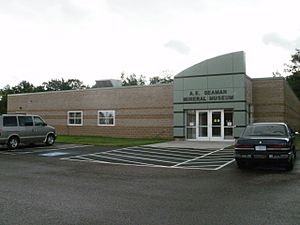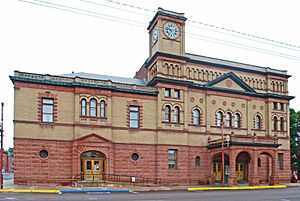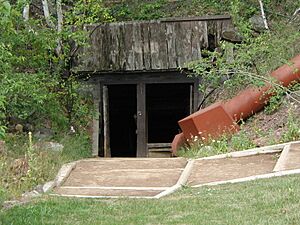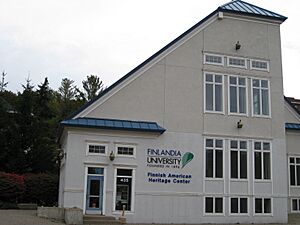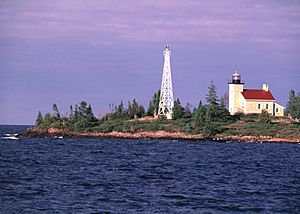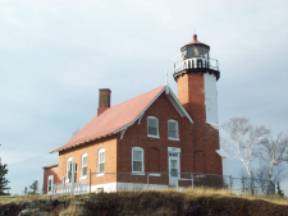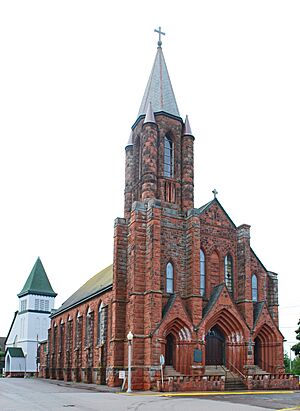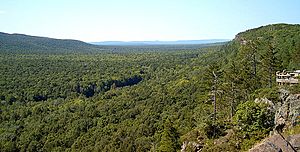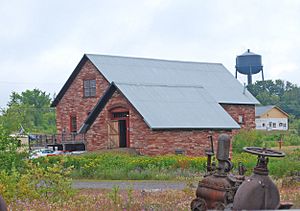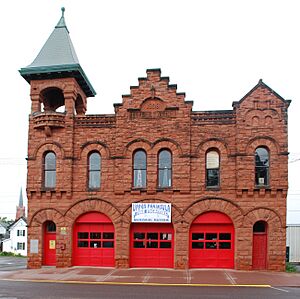Keweenaw National Historical Park facts for kids
Quick facts for kids |
|
|
Keweenaw National Historical Park
|
|
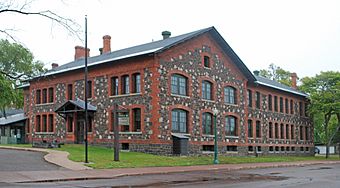
Park Headquarters
|
|
| Location | Upper Peninsula, Michigan, United States |
|---|---|
| Nearest city | Calumet, Michigan |
| Area | 1,869 acres (756 ha) |
| Visitation | 31,191 (2024) |
| NRHP reference No. | 01000108 |
| Designated NHP | October 27, 1992 |
The Keweenaw National Historical Park is a special place in Michigan, managed by the National Park Service. It was created in 1992 to celebrate the amazing history of the Keweenaw Peninsula. This area is famous for its copper mining past.
The park is a team effort between federal and local groups. It has two main parts: the Calumet Unit and the Quincy Unit. There are also almost two dozen "Heritage Sites" spread across the peninsula. These sites are on different lands, including federal, state, and private property. The National Park Service owns about 1,700 acres within the Calumet and Quincy Units. These units are found in Baraga, Houghton, Keweenaw, and Ontonagon counties.
The Keweenaw Peninsula holds some incredible secrets. It has the oldest and largest lava flow ever found on Earth. This ancient volcanic activity created the only place where you can find huge amounts of 97% pure copper. People have been mining copper here for about 7,000 years! Ancient Native Americans mined this copper and traded it far away, even as far south as present-day Alabama.
Contents
- Discovering Copper's Story
- Exploring Diverse Cultures
- Calumet Unit: A Town That Survived
- Quincy Unit: The "Old Reliable" Mine
- Exploring Heritage Sites
- Adventure Mining Company: Go Underground!
- A.E. Seaman Mineral Museum: Gemstone Wonders
- Carnegie Museum: Local History Hub
- Calumet Theatre: A Stage for Stars
- Coppertown USA Museum: Mining History Up Close
- Delaware Copper Mine: Oldest Mine Tours
- Finnish American Heritage Center: Connecting Cultures
- Fort Wilkins Historic State Park: History and Nature
- Hanka Homestead: A Finnish Farm Life
- Houghton County Historical Museum: A Look Back in Time
- Keweenaw County Historical Society: Lighthouses and Mines
- Keweenaw Heritage Center: Preserving Culture
- Laurium Manor Inn: A Mining Captain's Home
- Old Victoria: Miners' Log Homes
- Ontonagon County Historical Society: Local Treasures
- Porcupine Mountains Wilderness State Park: Nature's Beauty
- Quincy Mine Hoist and Underground Mine: Deep Dive Tours
- Upper Peninsula Firefighters Memorial Museum: Brave Heroes
- See also
Discovering Copper's Story
The Keweenaw Peninsula is home to the biggest known natural copper deposits in the world. This red metal was found in a very pure form. Early miners could break it from rocks and shape it into many items. They made jewelry and tools. Later, it was used for coins and electric wire.
People mined Keweenaw copper for about 7,000 years. This long history stretched from 5000 BCE until 1968. Records show that over 11 billion pounds (5 million metric tons) of copper were mined here. During World War I, in 1916–1917, copper production was at its highest. The area produced 270 million pounds (125,000 tons) of copper each year!
The story of copper mining in Michigan's Keweenaw Peninsula has three main parts. These are the Village of Calumet, the old Calumet and Hecla Mining Company properties, and the former Quincy Mining Company properties. Calumet shows the social, cultural, and business side of mining. The Calumet and Hecla buildings highlight the power of the mining companies. The Quincy Mining Company structures show how copper was dug up and processed.
Exploring Diverse Cultures
Many different groups of people helped shape the Keweenaw National Historical Park. From the late 1800s to the early 1900s, immigrants came from all over Europe. They moved to the Keweenaw to work in the copper mines. By 1910, people from French Canada, Germany, China, Ireland, Cornwall, Croatia, Finland, Italy, Greece, and Syria lived here.
When news of the rich copper spread in the 1830s, many families came from Cornwall, England. They brought their knowledge of hard-rock mining. They also brought the delicious Cornish pasty! Several park sites, like the "Old Victoria" log cabin village, show Cornish heritage.
Later in the 1800s, many families from Finland moved to the United States. Finland was part of Russia until 1918. Many Finns settled in the Western Upper Peninsula. They felt it was similar to their homeland and found work in the Keweenaw. You can still find Finnish saunas all over the area. Sites like the "Hanka Homestead" remember the Finnish people who came here.
Calumet Unit: A Town That Survived
The Calumet Unit of the park includes many places in and around Calumet and Laurium. These are not ghost towns. They are active communities that kept going even after the Calumet and Hecla Mining Company closed in 1968. Miners and owners of Calumet & Hecla dug deep shafts into the rock. They found rock formations filled with almost pure copper nuggets.
The Calumet & Hecla was the richest copper mine in the Keweenaw. The towns built near the mine showed its success. A huge 1,200-seat opera house, large churches made of Lake Superior brownstone, and fancy mansions built by mining bosses still stand. They remind us of Calumet mine's glory days.
Quincy Unit: The "Old Reliable" Mine
The Quincy Unit of the park celebrates an amazing engineering achievement. This is the 9,000-foot-deep Quincy Mine shaft. The Quincy mine was nicknamed "Old Reliable." It earned this name because it paid annual dividends (money to investors) for many decades. The mine was located on the rich copper rock of the Pewabic Lode.
A private group now keeps up the Quincy Mine's surface mine hoist. This hoist is the largest steam-powered hoist in the world. It's a huge machine that used to lift copper and miners from deep underground.
-
Quincy Smelting Works plan created by the HAER, National Park Service, Department of the Interior.
Exploring Heritage Sites
As of 2023, Keweenaw National Historical Park works with 23 heritage sites. These sites are located across the Keweenaw Peninsula and nearby areas. The heritage site system started in 2007 with 19 original sites. In October 2013, two new sites were added. These were Houghton's Carnegie Museum and the Michigan Technological University Archives.
Adventure Mining Company: Go Underground!
The Adventure Mining Company is in Greenland, Michigan. The Adventure Mine operated from 1850 to 1920. It had five shafts, with one going 1,300 feet deep. Even though it looked promising, the mine never made a profit. Today, the Adventure Mining Company offers tours. You can explore both the surface and underground parts of the mine.
A.E. Seaman Mineral Museum: Gemstone Wonders
The A.E. Seaman Mineral Museum is now located across from the Advanced Technology Development Complex in Houghton, Michigan. It used to be at Michigan Technological University. The museum is named after Arthur Edmund Seaman. He worked at Michigan Tech and was the museum's curator from 1928 to 1937.
The museum's mineral collection started in the 1800s. By 1890, it had 27,000 specimens. A special building for the museum was built in 1908. The museum has moved a few times since then. The collection has grown to over 30,000 specimens, with 8,000 on display. It has an amazing collection of minerals. You can see exhibits on how copper forms. It also has the world's best collection of crystallized native copper.
Carnegie Museum: Local History Hub
The Carnegie Museum in Houghton was once a Carnegie library. It was also home to the Portage Lake District Library. Now, it is a museum that focuses on the history of the local area.
Calumet Theatre: A Stage for Stars
The Calumet Theatre is in Calumet, Michigan, within the park's Calumet Unit. It was built in 1899 and opened on March 20, 1900. This was the first theater in the country built by a town! It hosted famous performers like Frank Morgan (from The Wizard of Oz), Douglas Fairbanks, Sr., and John Philip Sousa.
In the late 1920s, it became a movie theater until the 1950s. Live summer theater returned in 1958. The theater was restored in 1975 and again in 1988–89. Today, the Calumet Theatre hosts about 80 events each year. Around 20,000 people attend these shows.
Coppertown USA Museum: Mining History Up Close
The Coppertown USA Museum is in Calumet, Michigan, part of the Calumet Unit. It is located in the old pattern shop of the Calumet & Hecla Mining Company. The museum's exhibits cover the entire history of copper mining. This includes ancient times to the present day. It especially focuses on the Calumet & Hecla Mining Company.
Delaware Copper Mine: Oldest Mine Tours
The Delaware Copper Mine is off U.S. Highway 41. It is 12 miles south of Copper Harbor, Michigan. This mine offers tours of one of the oldest copper mines in the Keweenaw. It dates back to 1846. The mine had five shafts, with the deepest reaching 1,400 feet. The mine is open from June through October. It offers both guided and self-guided tours.
Finnish American Heritage Center: Connecting Cultures
The Finnish American Heritage Center & Historical Archive is on the campus of Finlandia University in Hancock, Michigan. It has a theater, an art gallery, and historical archives. These archives hold the largest collection of Finnish-North American materials in the world. The center connects Finnish communities in America and Finland. It does this through exhibits on Finnish history and traditions. The archives have 20,000 items. These include family history resources, cultural information, and artwork.
Fort Wilkins Historic State Park: History and Nature
Fort Wilkins Historic State Park is on US 41 in Copper Harbor, Michigan. The fort was built in 1844. It helped keep order and protected copper resources during the American Civil War. The park also has one of the first lighthouses on Lake Superior. You can enjoy camping, fishing, hiking, swimming, and biking here.
Hanka Homestead: A Finnish Farm Life
The Hanka Homestead is about 3 miles west of U.S. Highway 41 in Pelkie, Michigan. This is a Finnish-American "stump farm" homestead. It was first settled around 1900. The Hanka family lived on the farm until 1966. The farm has been restored to look like it did in 1920.
Houghton County Historical Museum: A Look Back in Time
The Houghton County Historical Museum is in Lake Linden, Michigan. It has over 100 years of photos and artifacts. Three floors of exhibits show local mining, logging, and cultural history. The museum also runs a narrow gauge railroad. It has a one-room schoolhouse, a church, a log cabin, and a research center.
Keweenaw County Historical Society: Lighthouses and Mines
The Keweenaw County Historical Society has five locations in Keweenaw County, Michigan. These include the Eagle Harbor Lighthouse, Central Mine Historic District, and the Phoenix Church. They also have the Rathbone School and the Bammert Blacksmith Shop. Visitor Centers are at the Eagle Harbor Lighthouse and Central Mine. Their sites are open from June through October.
Keweenaw Heritage Center: Preserving Culture
The Keweenaw Heritage Center is in the old Ste. Anne's church in Calumet, Michigan. This is part of the park's Calumet Unit. Ste. Anne's was built in 1900 as a French Canadian Roman Catholic church. It was closed in 1966. In 1994, local citizens bought the building. The center works to "preserve and interpret the culture and heritage of the Copper Country." They do this through buildings, exhibits, and educational activities. A large museum is planned for the first floor.
Laurium Manor Inn: A Mining Captain's Home
The Laurium Manor Inn is in Laurium, Michigan. This 13,000-square-foot house was built in 1908. It was the home of a rich mining captain, Thomas H. Hoatson. It cost $50,000 to build back then! Today, the house is a bed and breakfast. It is also open to the public for tours.
Old Victoria: Miners' Log Homes
Old Victoria is in Rockland Township, Michigan. This site has a group of small log houses. Miners from the Victoria Mining Company once lived in them. These cabins were built in 1899 and left empty in 1921. The houses were fixed up in the 1970s. You can take tours through the cabins and the old mine site.
Ontonagon County Historical Society: Local Treasures
The Ontonagon County Historical Society is in Ontonagon, Michigan. It was started in 1957. Its goal is to "collect and preserve the artifacts of the county's history." It also educates the public about that history. The museum has exhibits with items from early mining days and other topics. The Society also runs the Ontonagon Lighthouse. This lighthouse was built in 1851–52. The Society bought it in 2000 and offers tours in the summer.
Porcupine Mountains Wilderness State Park: Nature's Beauty
Porcupine Mountains Wilderness State Park is west of Ontonagon, Michigan. It is located on Michigan State Route 107. The park covers 59,000 acres. It offers day-hiking, backpacking, camping, canoeing, biking, and winter sports. You can also find many old copper mining sites within the park. There are also areas of untouched old-growth forests.
Quincy Mine Hoist and Underground Mine: Deep Dive Tours
The Quincy Mine Hoist and Underground Mine is in Hancock, Michigan. It is part of the park's Quincy Unit. The company offers tours of the Quincy Mine's surface buildings. They also offer exciting underground tours.
Upper Peninsula Firefighters Memorial Museum: Brave Heroes
The Upper Peninsula Firefighters Memorial Museum is in Calumet, Michigan. It is within the park's Calumet Unit. The second floor of the building has exhibits. These show the history of firefighting in Michigan's Upper Peninsula.
See also


